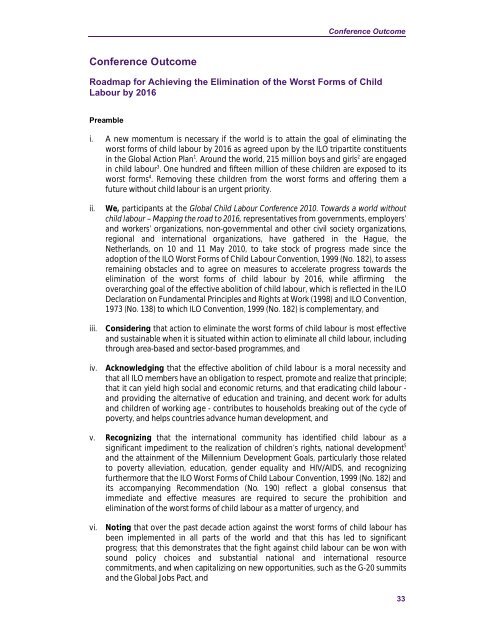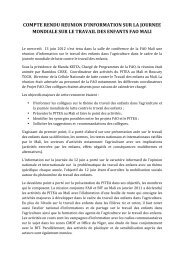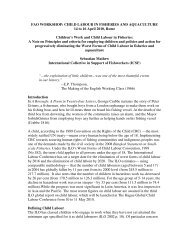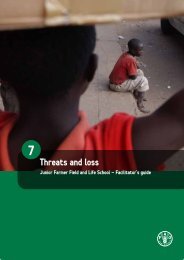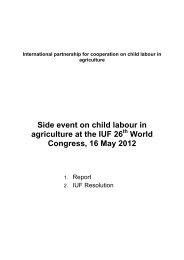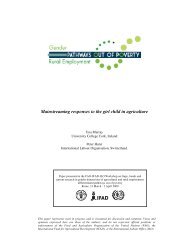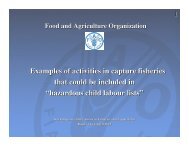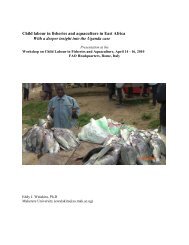The Hague Global Child Labour Conference 2010 - Food ...
The Hague Global Child Labour Conference 2010 - Food ...
The Hague Global Child Labour Conference 2010 - Food ...
Create successful ePaper yourself
Turn your PDF publications into a flip-book with our unique Google optimized e-Paper software.
<strong>Conference</strong> Outcome<strong>Conference</strong> OutcomeRoadmap for Achieving the Elimination of the Worst Forms of <strong>Child</strong><strong>Labour</strong> by 2016Preamblei. A new momentum is necessary if the world is to attain the goal of eliminating theworst forms of child labour by 2016 as agreed upon by the ILO tripartite constituentsin the <strong>Global</strong> Action Plan 1 . Around the world, 215 million boys and girls 2 are engagedin child labour 3 . One hundred and fifteen million of these children are exposed to itsworst forms 4 . Removing these children from the worst forms and offering them afuture without child labour is an urgent priority.ii.iii.iv.We, participants at the <strong>Global</strong> <strong>Child</strong> <strong>Labour</strong> <strong>Conference</strong> <strong>2010</strong>. Towards a world withoutchild labour – Mapping the road to 2016, representatives from governments, employers’and workers’ organizations, non-governmental and other civil society organizations,regional and international organizations, have gathered in the <strong>Hague</strong>, theNetherlands, on 10 and 11 May <strong>2010</strong>, to take stock of progress made since theadoption of the ILO Worst Forms of <strong>Child</strong> <strong>Labour</strong> Convention, 1999 (No. 182), to assessremaining obstacles and to agree on measures to accelerate progress towards theelimination of the worst forms of child labour by 2016, while affirming theoverarching goal of the effective abolition of child labour, which is reflected in the ILODeclaration on Fundamental Principles and Rights at Work (1998) and ILO Convention,1973 (No. 138) to which ILO Convention, 1999 (No. 182) is complementary, andConsidering that action to eliminate the worst forms of child labour is most effectiveand sustainable when it is situated within action to eliminate all child labour, includingthrough area-based and sector-based programmes, andAcknowledging that the effective abolition of child labour is a moral necessity andthat all ILO members have an obligation to respect, promote and realize that principle;that it can yield high social and economic returns, and that eradicating child labour -and providing the alternative of education and training, and decent work for adultsand children of working age - contributes to households breaking out of the cycle ofpoverty, and helps countries advance human development, andv. Recognizing that the international community has identified child labour as asignificant impediment to the realization of children’s rights, national development 5and the attainment of the Millennium Development Goals, particularly those relatedto poverty alleviation, education, gender equality and HIV/AIDS, and recognizingfurthermore that the ILO Worst Forms of <strong>Child</strong> <strong>Labour</strong> Convention, 1999 (No. 182) andits accompanying Recommendation (No. 190) reflect a global consensus thatimmediate and effective measures are required to secure the prohibition andelimination of the worst forms of child labour as a matter of urgency, andvi.Noting that over the past decade action against the worst forms of child labour hasbeen implemented in all parts of the world and that this has led to significantprogress; that this demonstrates that the fight against child labour can be won withsound policy choices and substantial national and international resourcecommitments, and when capitalizing on new opportunities, such as the G-20 summitsand the <strong>Global</strong> Jobs Pact, and33


